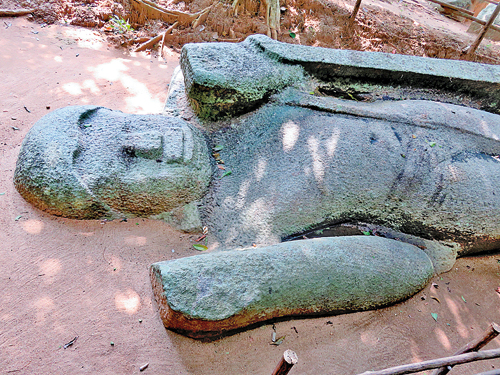Discovering the mysteries of a monastery in no-man’s land

Vast expanse: The Rajagalathenna ruins
No archaeological site in
Sri Lanka reveals more inscrutable mysteries to a visitor than this one. Reaching Rajagalathenna in the Eastern province itself is a challenge as it is situated in no-man’s land. Ampara is the closest hub, but Rajagala is over an hour’s journey from there.
We based ourselves on the coast of Kalkudah and used the brand new Chenkaladi-Badulla highway to reach the remote town of Maha Oya. It is where the great Sri Lankan surgeon cum author R.L. Spittel met his favourite Veddahs at the hamlet’s only rest house. Sadly, no trace of it remains now. The journey time from Maha Oya to the site on the Uhana Ampara old road is just an hour.
Rajagala was known as Rassagala where a tribe ‘Raksha’ seems to have lived in prehistoric times and since the mountain range resembles a resting crocodile from a distance, was named as ‘Girikhumbila’ during the King’s time. The ruins are spread over a vast expanse of 1,100 acres of forest of which only the centre of activities had been cleared to restore the monuments. It lies on a plateau at an elevation of 1000 feet from the onset. No less than 600 further mounds of ruin remain to be excavated and studied!
As per the chronicles, there had been four ascending accesses from the four main directions to the plateau though only two have been discovered so far. The one from the East that had been in existence since the site was known in recent times is the one commonly used. It’s a tedious journey from one boulder to another through the thick of the forest. Within the last decade, another longer path with proper steps has been added to join the former. It connects with tastefully built parking lots at the foothill, landscaped in line with the untouched environment. Either climb is over an hour we learnt.

The unfinished Buddha statue
The third Northern access route is the only motorable one but sadly it cannot be used unless prior permission is obtained from the Archaeological Department. It’s a 6 km route skirting the range, but the last 3 km are through dense jungle, heavily infested with wild elephants. The area is linked to the ancient Divulana Tank, home range of the giants and as such the corridor is their access to the fodder- rich Rajagala as well! However, we were fortunate to navigate the rugged path against all odds since our vehicle had good clearance, though we missed the animals. Perhaps, the lush surroundings after the monsoon and excess of water at hand may have made them sluggish.Our fine escort, a postgraduate student of Sri Jayawardenapura University who is also a site co-ordinator, unlocked the barrier and we were able to save our rickety knees in the end.
Earliest known records suggest Prince Lajjithissa, son of King Saddhathissa of 2 BC founded the site when he was ruling the rice bowl of Digamadulla and after developing it as a fully-fledged monastery complex, offered the facility to the monks upon succeeding his father to the throne. Subsequently, early Anuradhapura Kings,Walagamba, Buddhasa and Mahasena and the Agbo dynasty of late had patronized the monastery generously, adding more infrastructure to it. The complex flourished in the meantime but by the 9th century and with the decline of the Anuradhapura Kingdom, seemed to have gone into some form of oblivion. Archaeologists suspect a pandemic or a major natural disaster to be the reason than any unaccounted foreign invasion.

Large rock bowls used for storing water
The next 1500 years saw the wilderness swallowing what was left of the complex until the eminent archaeologist Senarath Paranavithana rediscovered the site in the 1940s. Before that, some British hunters and wanderers had recorded the mysterious ruins they had come across but did not succeed in diverting the Governor’s attention from numerous more prominent sites in the NCP they by then were engaged in restoring. Finally, when the Archaeological Department set eyes on the project, the site had been hopelessly vandalized by merciless treasure hunters of yore.
The stone ruins unearthed so far comprise many stupas, image and monastic houses, assembly halls, a vast refectory, rock ponds, majestic promenades, a lovely brimming lake to which stone steps from many directions descend, a classic drinking water storage facility using a natural spring which still sprouts, cave dwellings of the meditating monks with their customary drip-ledges, amazing wattle and daub separations still intact, numerous stone inscriptions in very early Brahimi Sinhalese, ancient rock-wall paintings, moonstones and guard-stones and an unfinished solitary Buddha statue.
Among all these, what stands as exceptional are the stupas with the shade of a parasol (chathra) instead of a more common pinnacle at the top. What juts-out from the summit as a long stone column is supposed to be originating from the sacred relic chamber itself – reflecting an image of Buddha – for which the stone shade is fixed in resolute respect. In addition, the mammoth rock bowls used for water storage are the largest ever recovered in the island. It’s not overly difficult to visualize the splendour of the Rajagala heyday with over 200 meditating monks, some noble Arahats among them, lined up serenely for their only meal for the day at the refectory.
Strangely, the stone inscription found next to the ‘Mihindu Seya’, where remains of Arahat Mahinda and Arahat Uththiya are enshrined, is one of the two archaeological proofs of the arrival of the Great One in the island. The structure of the stupa – a triangular collection of identical rough-stones – is the only one of its kind in Sri Lanka which oddly resembles ones found in the high altitudes of Tibet!

Stupa with a difference: Parasol instead of pinnacle
The fauna and flora of Rajagalathenna are vivid. The vegetation is that of a typical Dry Zone forest sundering rocky outcrops and it was magical finding a rare and gigantic 90 foot ‘dhorana’ tree – as old as time – next to the refectory. The ‘sawing of a leopard’ among the ruins was last heard nearly a decade back and sadly the last sighting of a sloth bear had been in the 80’s. They may be surviving in parts of the range not accessible yet. Elk, deer, fishing cat, crocodile are common whilst the thick canopy offers ample opportunities for keen bird watchers.
Rajagala is unique in many ways though comparable to more common ancient monastic complexes in Sri Lanka like Ritigala, Mihintale, Arankele, Rasvehera and Kiralagala but more importantly, it has left enough for archaeologists of the next hundred years to unravel for the benefit of the future generations. The present assignment is an ongoing one with the collaboration of the Sri Jayawardenapura University and is funded by the US Ambassador’s Cultural Fund. We are grateful for their untiring efforts.
After the arduous expedition, it was proven why we were taught with such persisting uniformity from the kindergarten as to why we should be proud of our inheritance. If one needs an affirmation, one has to visit a site like Rajagalathenna in one’s lifetime.



